Cats are fascinating, graceful creatures that have enthralled humans for millennia. We admire their elegance, independence, and mischievous spirit—but beneath that seemingly aloof exterior lies a playful, curious animal with natural instincts that need stimulation. One of the best ways to keep your cat physically fit and mentally engaged is by providing them with a variety of toys. From feather wands and puzzle feeders to laser pointers and scratching posts, the right toys cater to a cat’s innate behaviors—hunting, chasing, pouncing—and help stave off boredom or stress.
In this in-depth guide, we’ll explore the best types of toys for cats and discuss how to use them effectively. We’ll cover everything from interactive play sessions and puzzle toys to solo-play gadgets and environmental enrichment. By the end, you’ll have a well-rounded understanding of how to keep your feline friend happy, healthy, and active.
1. Why Toys Matter for Cats
a) Physical Exercise
While cats are known for enjoying naps in sunny spots, they still require regular exercise to maintain a healthy weight and strong muscles. Obesity and related health issues—like diabetes, joint problems, and heart disease—can arise if a cat stays inactive for extended periods. Toys that encourage chasing, pouncing, or leaping help burn calories and keep your cat agile.
b) Mental Stimulation
Cats are natural hunters. Even domesticated indoor cats retain instincts that drive them to stalk, chase, and catch prey. Engaging these instincts through toys not only channels pent-up energy but also wards off boredom, which can lead to destructive behaviors or stress-related problems. Interactive puzzles and treat-dispensing toys also challenge a cat’s mind, satisfying their curiosity and puzzle-solving tendencies.
c) Bonding and Socialization
Playing with your cat is an excellent way to strengthen your bond. Regular interactive sessions—where you move a toy that your cat can chase—allow your feline friend to associate you with fun and positive experiences. For multi-cat households, certain toys (like multiple feather wands or a large cat tunnel) can reduce tension by providing shared play opportunities in a communal space.
d) Confidence-Building
Toys can boost a cat’s confidence—especially for shy or timid felines. Successfully catching a toy mouse or batting a ball around gives them a sense of accomplishment, mirroring the satisfaction of a successful hunt. Over time, frequent positive play sessions can help less outgoing cats become more comfortable and secure in their environment.
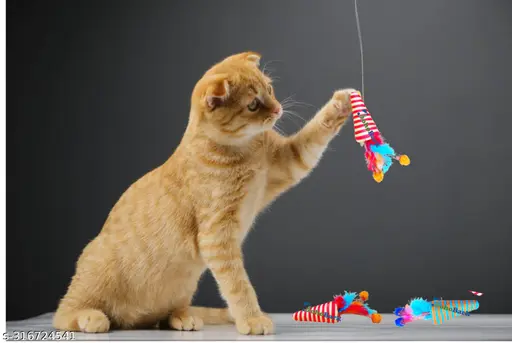
2. Feather Wands and Interactive Teasers
a) Why They’re Great
Few toys replicate the thrill of “the hunt” like a classic feather wand or interactive teaser. These toys typically consist of a long stick or flexible wand with a string attached, ending in feathers, fabric strips, or small plush shapes. When you wave or flick the wand, the fluttering feathers simulate prey in flight. This triggers your cat’s predatory instincts, urging them to pounce and chase.
b) How to Use Them
- Simulate Prey Movements: Move the wand in short, quick motions or let it bounce over furniture. Avoid predictable patterns—cats love unpredictability, just like real prey.
- Vary the Height: Let the toy dart across the floor or ascend to a chair’s height. This diversity of motion keeps the cat engaged.
- Allow Your Cat to “Win”: Every few moments, let the cat successfully grab the feathers. It provides them a sense of accomplishment and discourages frustration.
- Short Sessions, High Impact: Five to ten minutes of intense chasing can tire out even energetic felines. End on a positive note, letting them claim their “prey.”
c) Safety Considerations
- Always supervise wand play sessions to prevent the cat from entangling itself in the string.
- Store the wand out of reach when not in use—some cats will chew through strings or swallow small parts if left unattended.
3. Puzzle Feeders and Treat-Dispensing Toys
a) Mental Enrichment Through Food
Puzzle feeders or treat-dispensing toys are fantastic for cats that love a challenge. These typically involve containers with hidden compartments or rolling dispensers that release kibble or treats when manipulated. Engaging a cat’s intelligence and persistence, puzzle feeders replicate the thrill of working for food—a natural behavior in the wild.
b) Types of Puzzle Feeders
- Rolling Dispensers: Cylinder or ball-shaped toys with adjustable holes. As the cat bats it around, a small portion of kibble falls out. Great for encouraging movement during feeding.
- Stationary Puzzle Boards: Boards with slots, mazes, or cups the cat must navigate or fish out kibble from using paws. They require fine motor skills and concentration.
- Interactive Puzzle Towers: Vertical structures with multiple levels where cats must push treats down step by step. Ideal for more advanced problem-solvers.
c) Tips for Successful Use
- Start simple: If your cat is new to puzzle feeders, choose an easy model with large openings. Gradually move to more complex versions.
- Use high-value treats: Encourage initial engagement by placing especially tasty morsels inside.
- Monitor portion sizes: Account for the treats or kibble in your cat’s daily calorie intake to prevent overfeeding.
- Keep it interesting: Rotate puzzle feeder toys to prevent boredom.
4. Laser Pointers for High-Energy Fun
a) The Allure of the Chase
The laser pointer is a classic cat toy that taps directly into a cat’s chase instinct. That bright, quick-moving dot can send even the laziest feline bounding around the room. It’s an excellent form of exercise that requires minimal effort on your part—just point and move the light.
b) Responsible Play
While laser pointers are undeniably fun, use them responsibly:
- Avoid Direct Eye Exposure: Never shine the laser into your cat’s (or any person’s) eyes, as it can cause damage.
- Physical Catch: Some experts recommend ending the laser play session by directing the laser onto a tangible toy (like a stuffed mouse) so the cat can finally “catch” something. This helps alleviate frustration from chasing an uncatchable beam of light.
- Moderation: Keep sessions short. Overuse could lead to obsession or anxiety if the cat constantly hunts for the red dot even when it’s gone.
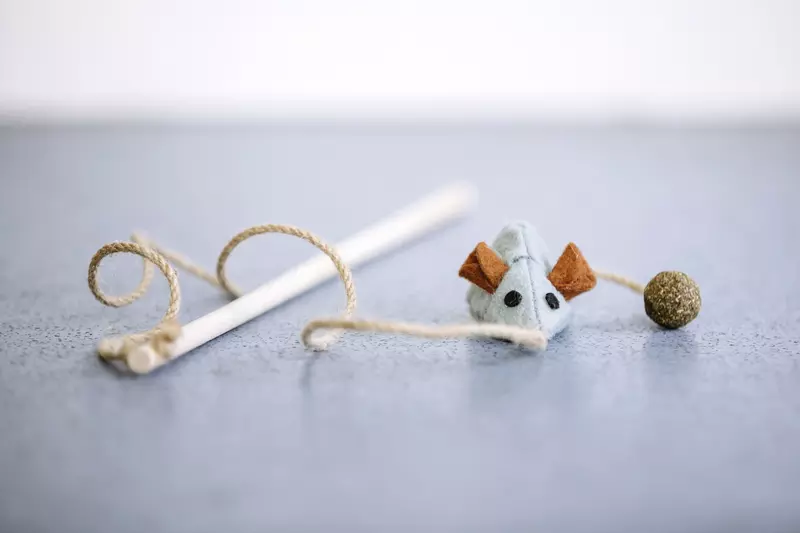
5. Catnip Toys and Plush Mice
a) The Catnip Effect
Catnip (Nepeta cataria) contains nepetalactone, a compound that many cats respond to with excitement or relaxation. When a toy is stuffed or sprayed with catnip, it can entice even indifferent cats into playful spurts—rolling, rubbing, and batting the toy around.
b) Choosing Catnip Toys
- Stuffed Mice or Soft Plush: Typically filled or coated with catnip, these are simple yet appealing. Some brands offer refillable pouches to replenish catnip potency.
- Durability: Cats can get rough when catnip is involved, so look for sturdy stitching.
- Vary Catnip Strength: Some catnip is more potent. If your cat doesn’t react to one brand, try others or consider silvervine or valerian root, which have similar effects on some felines.
c) Usage Tips
- Not all cats respond to catnip—some are genetically less sensitive.
- Catnip’s effect can last 5–15 minutes, after which the cat may lose interest for a while.
- Store catnip toys in a sealed container to prolong freshness.
6. Scratching Posts and Climbing Towers
a) Essential for Claw Maintenance
While not “toys” in the traditional sense, scratching posts and climbing towers provide vital outlets for cats’ natural behaviors. Cats scratch to keep their claws healthy, mark territory, and stretch their muscles. A sturdy scratching post or cat tree can double as an environment for playful climbing, jumping, and perching.
b) Features of a Good Scratcher
- Height: Tall enough for a full-body stretch.
- Stable Base: Prevents wobbling, so the cat feels secure while scratching.
- Texture: Sisal rope or sisal fabric is a popular choice that stands up to sharp claws. Cardboard scratchers are also affordable alternatives.
c) Multi-Level Cat Trees
If you have space and budget, a multi-tier cat tower with built-in scratching surfaces, platforms, and hideaways adds an enriching vertical dimension to your cat’s environment. Climbing up the tower can become part of their play routine, and placing dangling toys or feather attachments at different levels can encourage more activity.
7. Tunnels and Hiding Spots
a) Indoor Adventure
Cat tunnels mimic the experience of stalking through narrow passageways or dens. Many are made from crinkly fabric that produces rustling sounds when the cat moves inside, further fueling their curiosity and hunting drive.
b) Benefits
- Stimulates Exploration: Cats love peeking in and out of hidden nooks, pouncing on toys or each other from inside the tunnel.
- Multi-Cat Play: Tunnels can foster playful interactions between feline housemates, especially if there are multiple exit points.
- Compact Storage: Many fold up for easy storage when not in use.
c) Variations
- Single Straight Tunnel: Simple design, easy to place in the home.
- Multiple Intersecting Tubes: Larger tunnels with branches or T-junctions, adding complexity and more hidden corners.
- Integrated Dangling Toys: Some have a ball or feather attached to the entrance to entice the cat to venture inside.
8. Motion-Activated and Electronic Toys
a) Automated Entertainment
For times when you’re busy or away from home, electronic or battery-operated toys can keep cats engaged. Motion-activated toys respond when a cat bats them, spinning or shaking unpredictably, while some robotic toys roam around the floor, changing directions to maintain the cat’s interest.
b) Examples
- Motorized Mice: Little plastic mice that scuttle across hard floors.
- Fluttering Feather Toys: A wand attached to a base that rotates or bobs sporadically.
- Interactive Laser Robots: Battery-powered devices that project lasers in random patterns on walls or floors.
c) Precautions
- Quality: Cheaper electronic toys can break down quickly or have small parts that detach. Always supervise initially to check safety and durability.
- Battery Use: Keep spare batteries on hand, and turn off the toy when not in use to conserve power.
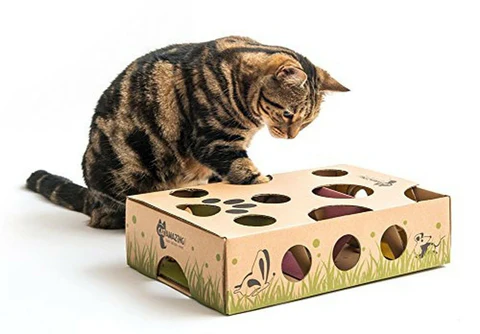
9. DIY and Budget-Friendly Options
a) Simple Creativity
Cat toys needn’t be expensive or elaborate. Often, household items can spark your feline’s interest just as well as store-bought gadgets:
- Cardboard Boxes: Most cats love exploring, chewing, or hiding inside boxes. Cut a few holes to create a DIY fortress.
- Paper Bags: A crinkly, plain paper bag can be a thrilling hiding and pouncing zone—just remove any handles to prevent entanglement.
- Homemade Yarn Pom-Poms: Tied securely to prevent unraveling, these make soft, chaseable objects.
- Toilet Paper Rolls: Fill with a bit of kibble or catnip, fold the ends, and let the cat bat it around.
b) Safety Tips
- Make sure there are no small or easily detachable parts that a cat can swallow.
- Avoid items like rubber bands, plastic strings, or tinsel that can cause internal blockages.
10. Ensuring Safe and Enjoyable Play
a) Rotate Toys
Cats can grow bored of seeing the same toy day after day. By rotating their collection—bringing out a few toys at a time while storing others—you maintain novelty and excitement. After a week or so, swap them around to rekindle your cat’s interest.
b) Supervision
Not all toys are safe for unsupervised play. Feathers, strings, or small parts can pose choking or entanglement hazards. Always monitor your cat initially with new toys and follow manufacturer recommendations regarding supervision.
c) Replace Damaged Toys
Inspect toys regularly for loose threads, frayed fabric, or dislodged components. A torn feather wand or ripped plush toy can reveal stuffing, string, or small plastic pieces that cats might ingest. Discard or repair any damaged items to avoid accidents.
d) Respect Boundaries
Each cat has its preferences and energy levels. If your cat suddenly loses interest or shows signs of irritation (e.g., twitching tail, flattened ears), give them space. Forced play can cause stress or even aggression.
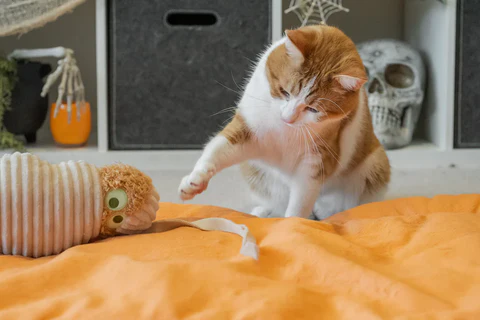
11. Tailoring Toys to Your Cat’s Personality and Age
a) Kittens
Kittens are brimming with curiosity and energy, so they’ll likely enjoy chasing anything that moves. However, their small size and developing motor skills mean:
- Choose lightweight, soft toys that are gentle on their teeth and claws.
- Provide plenty of interactive sessions to help them burn off energy and learn appropriate play behaviors.
- Avoid toys with easily swallowed parts or too-long strings that could entangle them.
b) Adult Cats
Adult cats may have refined preferences based on their established routines and personalities:
- Energetic Adults: Focus on wands, lasers, or puzzle feeders to keep them mentally and physically engaged.
- Laid-Back Cats: Might prefer softer, slower-paced toys or catnip plushies to cuddle. They may still enjoy gentle chases but tire out faster.
c) Senior Cats
Senior or arthritic felines still benefit from mild play to keep joints flexible and minds active:
- Gentle Movement: Use slow, rolling toys or short interactive sessions that don’t strain older bodies.
- Easier Access: Place toys where the cat can reach without jumping to high places.
- Soft Surfaces: Provide comfortable resting spots near their toys.
12. Encouraging Bonding and Reducing Stress
a) Multi-Cat Households
When you have multiple cats, tension can sometimes arise. Group play sessions with interactive toys—like a feather wand for them to chase simultaneously—can redirect aggression away from each other and towards a shared “prey.” Just ensure each cat can have a turn “catching” the toy to prevent competition or jealousy.
b) Stress Relief
Cats under stress (due to environmental changes, new pets, or routine disruptions) may exhibit unwanted behaviors like hiding, hissing, or excessive grooming. Playtime provides a healthy outlet for that nervous energy. Introducing calming elements—like catnip or calming diffusers—alongside gentle play can further ease tension. Over time, consistent, positive interactions restore a sense of control and comfort.
13. Working with Your Cat’s Natural Schedule
Cats are often crepuscular, meaning they’re most active at dawn and dusk. Incorporate play sessions around these times for maximum engagement. If your cat wakes you up early, scheduling a quick 10-minute play session before bedtime can help them expend energy, allowing them (and you) to sleep more soundly overnight.
14. Building a Toy Collection Over Time
You don’t need to purchase all toy types at once. Pay attention to how your cat responds to each new item:
- Try Different Categories: Start with a wand or a catnip mouse to gauge interest, then add puzzle feeders or tunnels if you sense your cat wants more variety.
- Observe Behavior: Some cats go wild for plush mice or rattling balls, while others prefer chasing lasers or feathers. Let your cat’s preferences guide future purchases.
- Seasonal Upgrades: Use cat birthdays or holidays as opportunities to introduce new toys, keeping the environment fresh and fun.
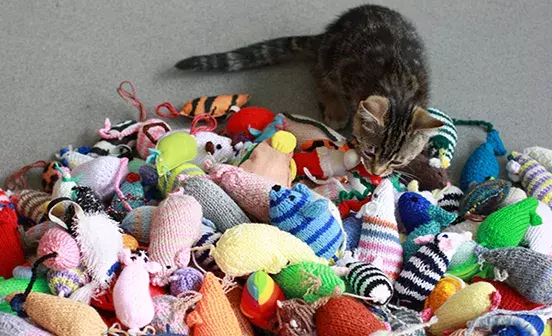
15. Conclusion
Providing your cat with an engaging assortment of toys is more than just a treat—it’s a vital component of their physical health, mental stimulation, and emotional well-being. From the thrill of pouncing on a feather wand to the satisfaction of solving puzzle feeders or the camaraderie of chasing through tunnels, the best toys address a cat’s natural instincts while strengthening your bond in the process.
Remember, variety is key. Consider your cat’s individual personality, age, and energy level, and rotate or upgrade toys regularly to maintain novelty. Keep safety in mind by supervising play with potentially hazardous items and discarding damaged toys. And most importantly, embrace those playful moments as a chance to connect with your feline friend, celebrating the beautiful blend of independence and affection that makes cats such cherished companions.
By investing in a few well-chosen toys and dedicating time each day for interactive or solo play, you’ll foster a happier, healthier cat—one who’s confident, physically fit, and perpetually intrigued by the world around them. So gather those feather wands, puzzle feeders, catnip mice, and more, and watch your cat come alive with excitement as you share the joys of play together.
